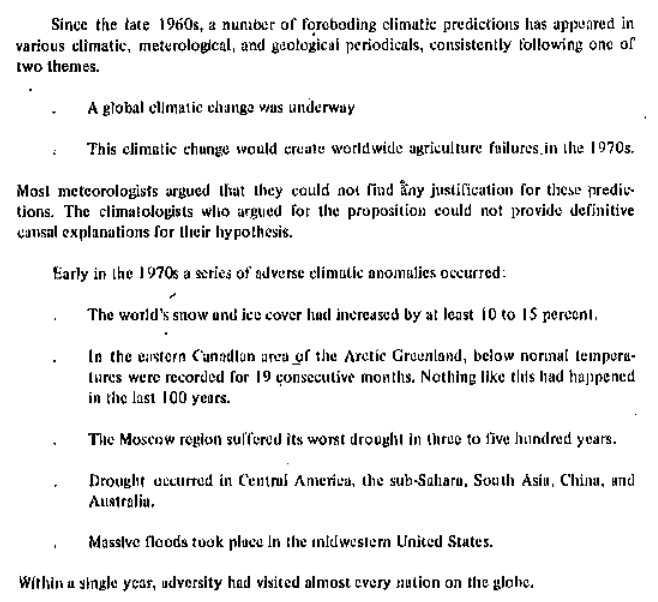TIME Magazine June 1974: Another Ice Age?
In Africa, drought continues for the sixth consecutive year, adding terribly to the toll of famine victims. During 1972 record rains in parts of the U.S., Pakistan and Japan caused some of the worst flooding in centuries. In Canada’s wheat belt, a particularly chilly and rainy spring has delayed planting and may well bring a disappointingly small harvest. Rainy Britain, on the other hand, has suffered from uncharacteristic dry spells the past few springs. A series of unusually cold winters has gripped the American Far West, while New England and northern Europe have recently experienced the mildest winters within anyone’s recollection.
As they review the bizarre and unpredictable weather pattern of the past several years, a growing number of scientists are beginning to suspect that many seemingly contradictory meteorological fluctuations are actually part of a global climatic upheaval. However widely the weather varies from place to place and time to time, when meteorologists take an average of temperatures around the globe they find that the atmosphere has been growing gradually cooler for the past three decades. The trend shows no indication of reversing. Climatological Cassandras are becoming increasingly apprehensive, for the weather aberrations they are studying may be the harbinger of another ice age.
TIME Magazine June 1974: Another Ice Age? « Follow The Money
The CIA blamed record drought and flooding on global cooling.



I exspect to see this on the nightly LSM? LOL
Doesn’t sound any different than today’s alarmism over AGW or climate change, same propaganda and alarm based off of nothing more than outrageous claims that have no factual base whatsoever. Only this time, these people are manipulating the data and controlling the media and are deeply entrenched into the government’s pockets, even more so than in the 1970s.
According to the book Hubert Lamb wrote in 1976, the cooler climate in the 60’s and 70’s led to:-
Greater concentration of the equatorial rains near the equator.
Reduced rainfall and failures of the monsoons over the zones near 10-20o N and 12-20o S (and farther South).
Much smaller changes over middle latitudes, where the most significant feature has been the very awkward type of variability from year to year, associated with the behaviour of blocking systems and meridional circulation patterns.
Substantially increased downput (mainly snow) in the highest Northern Latitudes.
The effects included
Examples of the consequences of these features include a number of serious items besides the extremes of cold and warmth, drought and flood associated with the occurrences of blocking in middle latitudes.
The greater yield of equatorial rains since 1961 over the equator led to abrupt rises of the levels of the great lakes there, drowning harbours and much land.
But , far more serious were the droughts in the zones to the North and South. In the Sahel between 200,000 and 400,000 died in the drought of 1972-73.
In those parts of N and NW India, near the limit reached by the summer monsoon, Bryson (1973) has noted a corresponding effect, scarcely less threatening to the inhabitants than the 6 year drought from 1968-73 in the West African Sahel.
http://notalotofpeopleknowthat.wordpress.com/2012/06/28/hh-lambclimate-present-past-futurevol-2in-reviewpart-ii/
But, there again, he was a proper scientist, so what would he know?
In his book Lamb also talks about a study in 1973 by the Japanese Met Office, which was set up In response to public demand for information about the apparent increase in incidence of exceptional weather in recent years”.
It was based on a study of 150 stations across the world and found, that in terms of departure from the previous 30 year average:-
1) In the case of monthly mean temperatures, anomalies [i.e. warmer and/or colder] had increased with each successive decade since 1940, with a predominance of departure towards the low temperature side. From 1961 on, the frequency of significantly cold months was more than double that of significantly warm months.
2) There was no noteworthy variation in the occurrence of precipitation anomalies until 1960, but in the later years their frequency was very significantly increased with cases of deficient rainfall about 1.6 times as frequent as cases of excessive precipitation.
They’ve lost their ‘spin’ mojo. Meanwhile they flail about blaming every weather event on increased amounts of atmospheric CO2. They cherry pick inclement weather, and call it climate (change). As Nancy Pelosi says: God Bless them.